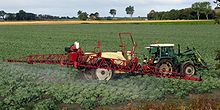Vegetable growing
As a vegetable to describe the culture of vegetables for human consumption. The acquisition is part of vegetable gardening and can be determined by the intensity of land use in three categories: the field vegetables , the horticultural field vegetable and glasshouse vegetable .
Field vegetable growing
Typical for field vegetable growing is the mostly only one-time use of the cultivated area per year and regular crop rotation with other agricultural crops. After the soil has been prepared, which results in a loose, weed-free, pre-fertilized, ready-to-plant or seed-ready arable top , the vegetables to be grown are either sown immediately or planted as pre-cultivated young plants. The field as a cultivated area is often divided into beds , in the case of carrots also dams; the bed widths are determined by the track width of the tractor and the working widths of the other machines used for cultivation and harvesting. Cultivation takes place in rows within the beds. Field vegetable growing requires a high degree of mechanization , on the one hand to have the necessary clout in the few days that are favorable for a work step, and on the other hand to be able to work economically successfully despite the low prices paid on the market for the vegetables. The workers required for planting and harvesting or preparing the harvest often come from other Eastern European countries because the work is hard and the wages are low. In the large-scale, contractually secured cultivation of vegetables for the food industry (e.g. for the production of canned food ), field vegetable growing is also referred to as industrial vegetable growing .
Horticultural field vegetable growing
A characteristic of the horticultural cultivation of vegetables in the open is the intensive use of the cultivated areas by two to four crops in one year (for example by the cultivation sequence savoy cabbage - lettuce - cauliflower in the period from mid-March to early October). In order to achieve the dense cultivation sequence, the vegetable plants are regularly pre-cultivated elsewhere (also under glass) and, as the space requirements increase, they are transplanted onto the actual cultivation area as growth progresses. At the same time, opportunities to earlier or to extend the harvest time can also be used at the final location, for example by covering with foils or fleeces.
Greenhouse vegetable growing

Greenhouse vegetable growing includes the cultivation of vegetables in heated or unheated greenhouses including foil tunnels until they are harvested . In greenhouse cultivation, vegetables are grown that either have an increased heat requirement or should go on sale much earlier or later than possible from open-air farming . Greenhouse vegetable cultivation is possible all year round, not only in traditional soil culture, but also in soil-free cultivation methods. For example, when growing on cubes made of foam (e.g. PU ) or rock wool (e.g. Grodan water-sucking) or in the thin-layer culture method, the nutrients necessary for the plant are supplied in a nutrient solution by means of irrigation fertilization. This minimizes the risk of pests and enables an ideal supply of nutrients.
Classification of vegetable crops
A further subdivision of vegetable production is possible by classifying the plants in production:
literature
- Christoph Wonneberger, Fritz Keller: Vegetable growing , Ulmer, Stuttgart 2004, ISBN 978-3-8001-3985-9
- Heinz Bahnmüller: Horticultural Management: Production Horticulture / Service Horticulture , Ulmer, Stuttgart 2004, ISBN 978-3-8001-4146-3
- Helmut Krug, Hans-Peter Liebig, Hartmut Stützel: Vegetable production , Ulmer, Stuttgart 2003, ISBN 978-3-8001-3584-4
- Lothar Bendel: The great lexicon of fruits and vegetables. Origin, ingredients, preparation, effect , Anaconda, Cologne 2008, ISBN 978-3-86647-201-3
- Michael Pollock: Fruit and Vegetable Growing: The Practical Encyclopedia. 150 types of fruit, vegetables and herbs. With detailed plant portraits: location, soil, sowing, ... Tips on storage and pest control , Dorling Kindersley, Munich 2002, ISBN 978-3-8310-0369-3
- John Seymour : Self-sufficiency from the garden: How to cultivate your garden naturally and harvest healthy food , Urania, Freiburg 2009, ISBN 978-3-7831-6145-8
- Ulrich Sachweh (editor): The gardener, volume 3, tree nursery, fruit growing, seed growing, vegetable growing . 2nd edition, Ulmer, Stuttgart 1986/1989, ISBN 3-8001-1148-9 , in particular Section C from p. 167 ff.
Individual evidence
- ^ Ulrich Sachweh (editor): The gardener, Volume 3, tree nursery, fruit growing, seed growing, vegetable growing . 2nd edition, Ulmer, Stuttgart 1986/1989, ISBN 3-8001-1148-9 , p. 167
- ↑ Ulrich Sachweh (editor): The gardener, Volume 1, Basics of horticulture . 5th edition, Ulmer, Stuttgart 1984, 2001, ISBN 3-8001-1184-5 , p. 380

